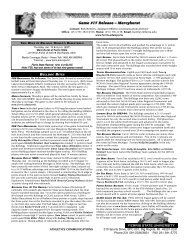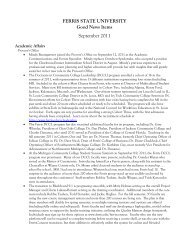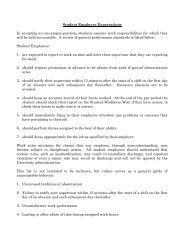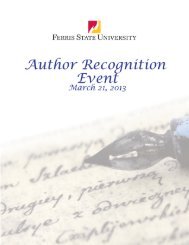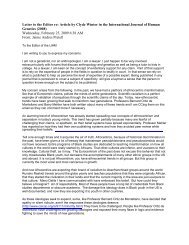Tavia Nyong'o Racial Kitsch and Black Performance - Ferris State ...
Tavia Nyong'o Racial Kitsch and Black Performance - Ferris State ...
Tavia Nyong'o Racial Kitsch and Black Performance - Ferris State ...
You also want an ePaper? Increase the reach of your titles
YUMPU automatically turns print PDFs into web optimized ePapers that Google loves.
<strong>Tavia</strong> Nyong’o<br />
<strong>Racial</strong> <strong>Kitsch</strong> <strong>and</strong> <strong>Black</strong> <strong>Performance</strong><br />
If kitsch is failed seriousness, as the modernist art critic Clement<br />
Greenberg has proposed, then the racist kitsch that we still occasionally<br />
encounter in flea markets, on trips abroad, <strong>and</strong> in galleries <strong>and</strong><br />
museums of contemporary art might be defined as failed humor (see<br />
Figures 1 <strong>and</strong> 2). <strong>Kitsch</strong>, according to Greenberg, attempts to say<br />
something profound, but can utter only clichés. Its abject failure is an<br />
embarrassment. The sub-genre of racist kitsch, which was largely ignored<br />
by the modernists, attempts by contrast to say something banal.<br />
In its failed effort to move unobtrusively among the objects of our<br />
everyday encounter, racist kitsch unwittingly reveals itself to be profoundly<br />
laden with meaning. Attempting to remain ephemera at the<br />
periphery of our vision, racist kitsch in fact holds our gaze, stops our<br />
conversations, <strong>and</strong> in its dem<strong>and</strong> for attention in spite of itself, is an<br />
equal embarrassment. 1<br />
Racist kitsch is pretty disgusting.To well-meaning people today, <strong>and</strong><br />
especially to those of us racialized as “others,” the only pleasurable response<br />
to it is the pleasure of mastering the urge to laugh with the<br />
joke.Through disgust, we reassert our dignity <strong>and</strong> attain distance from<br />
the pleasure that the stereotype urges upon us. This oppositional distance<br />
places the racist object in a new frame, one in which the object<br />
is re-signified. From a token of mundane racist enjoyment, it becomes<br />
a totem of our racial survival. 2<br />
Our disgust tells us that we are not the audience solicited by the<br />
object, that we are not the people who would find the object harmless<br />
fun. Disgust reasserts the boundaries of the body when it comes<br />
in potential contact with literal or metaphorical excrement. 3 The<br />
pleasure of disgust comes when we recover bodily integrity in the face<br />
of the dis-equilibrium presented by somebody else’s shit. In the particular<br />
case of racist kitsch, disgust apprehends the object as a kind of<br />
body that we are not, or, at least, one that we are no longer. It draws<br />
a boundary, not only against the object’s complicit audiences, but also<br />
against the object itself.<br />
Strong disgust dem<strong>and</strong>s an immediate tactic or gesture to reassert<br />
dignity.The original response intended by the creators of racist kitsch,<br />
<strong>and</strong> now sedimented firmly into the unmemorialized pasts of white<br />
The Yale Journal of Criticism, volume 15,number 2 (2002): 371–391<br />
© 2002 by Yale University <strong>and</strong> The Johns Hopkins University Press<br />
tavia nyong’o 371
Figure 1: Courtesy Aisha Bastiaans, copyright 1999.<br />
supremacy, is simply to laugh at the object. A more contemporary <strong>and</strong><br />
oppositional tactic might be to destroy the object physically <strong>and</strong> thus<br />
end the intolerable question of its significance. In this vein, some recent<br />
critics have objected strongly to the curating or creating of racist<br />
kitsch, even with an oppositional gaze or intent. In different ways, two<br />
recent critics of “black memorabilia” reject the possibility that such an<br />
oppositional curating or creative practice could succeed. Racist kitsch<br />
is simply “visual terrorism,” Robin Ch<strong>and</strong>ler observes, <strong>and</strong> Michael<br />
Harris, agreeing, suggests that because such kitsch “is linked to, <strong>and</strong> a<br />
product of, white imagination,” the “attempt to invert <strong>and</strong> reconstruct<br />
another’s dreams inevitably keeps one tied to <strong>and</strong> preoccupied with<br />
that other rather than the self.” 4<br />
Such criticism amounts to a theoretical destruction of the kitsch object:<br />
it attempts to imagine or invent a discursive <strong>and</strong> cultural space in<br />
372<br />
t he yale journal of criticism
Figure 2: Courtesy Aisha Bastiaans, copyright 1999,<br />
which the object of racist kitsch might no longer matter. The space<br />
produced through this imagined violence is occupied by an undifferentiated<br />
<strong>and</strong> collective black self, one that need never enter into relation<br />
with another. Such an approach solves the problem of history, <strong>and</strong><br />
of racism, simply by wishing them away.<br />
Another contemporary reaction, only superficially opposite, would<br />
be to curate the object, or to own it, <strong>and</strong> in these acts of curating<br />
<strong>and</strong>/or ownership, to modify the object in such a way as to render<br />
legible upon its surface the practices of our disgust. What happens<br />
tavia nyong’o 373
Figure 3: Film still from Bamboozled, copyright 2000.<br />
when we attempt to collect or curate racist kitsch (see Figure 3), to<br />
take ownership of it by modifying it so that it does not produce disgusting<br />
pleasure but a pleasurable disgust, or even an aesthetic experience<br />
on the order of the beautiful or the sublime?<br />
What would be the consequence if an examination of such strategies<br />
of oppositional curating <strong>and</strong> ownership unexpectedly revealed that<br />
one key characteristic of the racist figure was its ability to retain, even<br />
under the powerfully revisionary gaze of disgust, the capacity to act as<br />
a scapegoat or effigy? 5 Could it be the case that our oppositional gaze<br />
<strong>and</strong> attendant practices depend upon the effigy’s characteristic talent<br />
for absorbing blame, <strong>and</strong> thus, that they perpetuate our dependence<br />
upon scapegoating <strong>and</strong> its attendant cruelties?<br />
In raising the issue of scapegoating, I am also seeking to provide a<br />
critique of the oppositional gaze from the st<strong>and</strong>point of recent theoretical<br />
inquiry into shame. 6 The transformational powers of performance<br />
are available, this vein of criticism suggests, through resisting<br />
the pleasures of disgust <strong>and</strong> the temptation to reassert our bodies’<br />
imagined borders. Instead, queer criticism suggests, power might ac-<br />
374<br />
t he yale journal of criticism
Figure 4: Reproduced with permission from the collections of the John Hay Library, Brown<br />
University.<br />
crue from a confrontation with bordering work, from a dismantling<br />
of the protections of disgust, <strong>and</strong> from an embracing of shame <strong>and</strong> abjection<br />
as a point of departure. 7 It is through this suggestive new approach<br />
that I will attempt to reread the political <strong>and</strong> visual dynamics<br />
of racist kitsch, beginning in the nineteenth century, continuing with<br />
the film <strong>and</strong> television phenomenon, the Little Rascals, <strong>and</strong> culminating<br />
with a consideration of the recent film Bamboozled (2000), directed<br />
by Spike Lee.<br />
Toward a Genealogy of Performing <strong>Black</strong> Children<br />
Discussions of racist kitsch tend to notice especially the figures of<br />
Mammy <strong>and</strong> Uncle Tom. 8 Equally important to me is another invention<br />
of the nineteenth century:Topsy, the performing black child (see<br />
Figure 4). In Harriet Beecher Stowe’s novel, Uncle Tom’s Cabin (1852),<br />
Topsy is introduced as an example of the degraded condition into<br />
which children fall under the system of chattel slavery. When she is<br />
tavia nyong’o 375
discovered by the kind-hearted plantation owner Augustine St. Clare<br />
she is dirty, parentless, abused, <strong>and</strong> without instruction in the gospel.<br />
St. Clare hears her screams as she is being beaten, <strong>and</strong> buys her away<br />
from a cruel master to salve his conscience.Yet, unable to admit his sentimentality,<br />
St. Clare pretends to members of his family that he bought<br />
Topsy simply because she was “rather a funny specimen in the Jim<br />
Crow line.” 9 Hearing a child being beaten, St. Clare replaces this with<br />
what psychoanalysis calls a ‘screen memory’ of a child performing. 10<br />
Topsy enters the St. Clare household as surplus. The St. Clare residence<br />
is already teeming with numberless black children who are perpetually<br />
underfoot their betters. St. Clare’s abstemious visiting cousin<br />
from the North, Ophelia, is horrified at the extravagance of Topsy’s<br />
purchase, especially given St. Clare’s claim that it was a whim. She is<br />
even more distraught to be assigned the task of educating <strong>and</strong> Christianizing<br />
the irrepressible Topsy, who famously boasts of her natal<br />
alienation:“Never was born . . . never had no father nor mother, nor<br />
nothin’ ...I spect I grow’d. Don’t think nobody never made me.” 11<br />
In the novel Topsy is eventually civilized, not by the harsh discipline<br />
of the compassionless woman she sarcastically calls “Feely,” but instead<br />
by the sentimental power of Evangeline, the daughter of Marie <strong>and</strong><br />
Augustine St. Clare. It is Little Eva’s feeling for Topsy that precipitates<br />
the morally transformed character, who by novel’s end is cleaned up,<br />
free, <strong>and</strong> off on a Christian mission to Africa.<br />
Stage versions of Uncle Tom’s Cabin, the indispensable play of the late<br />
nineteenth-century American theater <strong>and</strong> para-theater, sometimes<br />
capitalized on Topsy’s transformation from wild child to demure<br />
Christian. But more commonly they misread Stowe’s novel <strong>and</strong> took<br />
St. Clare at his word when he claimed to have bought Topsy as entertainment,<br />
<strong>and</strong> left her laughably reprobate. On stage, she performed<br />
St. Clare’s screen memory. As an entertainer, Topsy quickly became<br />
one of the most popular characters in the play, as necessary as Uncle<br />
Tom. Actors playing Topsy sometimes received top billing in midnineteenth<br />
century productions, <strong>and</strong> Topsy’s song was a hot seller in<br />
sheet music. Rival productions of Uncle Tom’s Cabin were soon advertising<br />
two Topsies—double the fun <strong>and</strong> fidelity to Stowe’s novel be<br />
damned. 12<br />
Topsy’s conquest of the l<strong>and</strong>scape of United <strong>State</strong>s popular culture<br />
makes her an inaugural figure in the genealogy of performing black<br />
children. She appears at a historical moment where a white supremacist<br />
<strong>and</strong> slaveholding nation was actively debating “the character <strong>and</strong><br />
destiny” of black folk. Within this debate were anxieties over the potential<br />
demographic explosion of a freed people of color, anxieties that<br />
manifested in the form of soberly scientific explanations about why<br />
the Negro would naturally die out if not under the pastoral care of<br />
slavery. This fantasy, also manifest in the counterfactual but common<br />
376<br />
t he yale journal of criticism
Figure 5: Film still from Bamboozled, copyright 2000.<br />
sense belief that “hybrid” progeny between the races would be infertile<br />
(hence the echo of “mule” in the popular usage of “mulatto”),<br />
was belied by demographic reality.The Malthusian spectacle of a slavish<br />
class reproducing uncontrollably animated the popular consciousness<br />
that found in Topsy a scapegoat figure capable of resolving these<br />
tensions. 13<br />
In sharp contrast to the beloved Little Eva, whose angelic presence<br />
evoked tender memories for many bereaved white mothers <strong>and</strong> fathers<br />
(including Stowe herself, who had lost an infant son), Topsy is<br />
parentless <strong>and</strong>, in lacking Eva’s qualities of feminine Christian sentiment,<br />
peculiarly genderless. Eva is not just well behaved, she is perfectly<br />
innocent, so perfect that her death of consumption was depicted<br />
on stage as a saint’s apotheosis. She is literally too good for this world.<br />
Topsy, who is subjected to continuous physical abuse by Aunt Ophelia<br />
<strong>and</strong> the house slaves, is so hardy she is almost insensate. She is fun<br />
to kick; even she finds it fun. Eva is one of a precious few.Topsy is part<br />
of a disturbing <strong>and</strong> disgusting surplus. The violence done upon her is<br />
the performance of waste. 14<br />
The shiny, hard, <strong>and</strong> brittle surfaces of racist ceramic figurines reflect<br />
back upon the psychology of scapegoating black children. If the<br />
classical Hollywood techniques of film lighting seem peculiarly appropriate<br />
to the production of whiteness, as Richard Dyer has suggested,<br />
then the material form of the ceramic figurine seems, contrariwise,<br />
particularly apt for specifying blackness as a hardened form<br />
of subjectivity. 15 In this racial simile, a black skin is as hard as stone;<br />
not skin at all, but a mask, with perhaps nothing behind it. This invulnerability<br />
provides an alibi for racist violence (see Figure 5), salving<br />
the guilt that accompanies the wish to punish the black child purposelessly.<br />
16 This enjoyment completes the ideological ruse by finding<br />
tavia nyong’o 377
Figure 6: Little <strong>Black</strong> Sambo <strong>and</strong> Tiger. Reproduced with permission from the collections of the<br />
Beinecke Rare Books <strong>and</strong> Manuscripts Library, Yale University.<br />
within itself the occasion for a feeling of benevolence towards the<br />
scapegoat. Even moments of jarring violence are remembered as a<br />
charming encounter with a pickaninny. A bodily metaphor that<br />
people turn to in describing this pleasurable <strong>and</strong> guilty violence is eating.<br />
The performing black child is either hungry or eating or being<br />
eaten, or, ideally, all three.<br />
The Story of Little <strong>Black</strong> Sambo, an odd <strong>and</strong> almost impossibly naïve<br />
text, illustrates the edibility of the performing black child. 17 In the<br />
story, Sambo is set off for a walk in a set of colorful new clothes <strong>and</strong><br />
accessories, which he is forced to give up, one by one, to a series of<br />
rapacious tigers (see Figure 6). Having avoided being eaten through<br />
the performance of this strip tease, Sambo then witnesses the tigers<br />
fight ferociously until they melt into a pool of clarified butter, which<br />
378<br />
t he yale journal of criticism
Figure 7:The Sambo family eating Tigers. Reproduced with permission from the collections of<br />
the Beinecke Rare Books <strong>and</strong> Manuscripts Library, Yale University.<br />
is collected <strong>and</strong> used to fry up a delicious meal for Sambo <strong>and</strong> his parents<br />
(see Figure 7). The story defers <strong>and</strong> ultimately disavows its desire<br />
to eat Sambo, making a visual meal of the threatening tigers instead.<br />
This popular story was made into at least one play for the children’s<br />
theater, <strong>and</strong> is still in print today. 18<br />
If the cute black child is good enough to eat, she is also tough as<br />
nails.This toughness is suggested not so much in actual children, who<br />
are neither hard nor brittle nor invulnerable to pain, but rather in the<br />
materiality of the ceramic figurine.The racialized function of the figurine<br />
within consumer culture dates back to the dissemination in the<br />
late 1780s of the Jasperware Wedgewood medallion that famously portrayed<br />
a kneeling slave declaring “Am I not a man <strong>and</strong> a brother?” 19<br />
The historical <strong>and</strong> ideological links between this sort of abolitionist<br />
collectible <strong>and</strong> the commodification, beginning with the popular appropriation<br />
of Uncle Tom’s Cabin, of the racist kitsch figurine, have yet<br />
to be fully traced. I want to suggest that the material dynamics of the<br />
figurine, which invite the enjoyable practices of abuse, <strong>and</strong> which also<br />
anticipate <strong>and</strong> accept the abuse that our revisionary <strong>and</strong> oppositional<br />
practices enact upon them, form the concrete obstacle to any utopian<br />
regime of non-racist visual enjoyment. 20<br />
tavia nyong’o 379
Figure 8: Scene from Our Gang. Film still from Bamboozled, copyright 2000.<br />
Our Gang/Little Rascals<br />
The difficulties intrinsic to any wished-for escape from the shame of<br />
America’s racial past are evident in the shifting fortunes of the film<br />
<strong>and</strong> television phenomenon Our Gang, also known as the Little Rascals<br />
(see Figure 8). In remarking upon this fixture of American childhood<br />
from my gr<strong>and</strong>mother’s day up to my own, I focus especially on<br />
the “peculiar” rascals: Ernie (“Booker T. Bacon,” “Sorghum,” “Sunshine<br />
Sammy”) Morrison, Allen (“Farina,”“Maple”) Hoskins, Eugene<br />
(“Pineapple”) Jackson, Jannie (“Mango”) Hoskins, Matthew<br />
(“Stymie”) Beard, Bobbie (“Cotton”) Beard, <strong>and</strong> the three children<br />
named “Buckwheat”: Carlena Beard, Willie Mae Taylor, <strong>and</strong> most famously,<br />
Billie Thomas.<br />
What links these rascals, besides the fact that they are nearly all<br />
named after breakfast foods or exotic fruits, is their location in a racialized<br />
entertainment industry as performing black children. Although<br />
the culture industry they worked in undoubtedly participated in the<br />
establishment <strong>and</strong> maintenance of racial inequality, what is interesting<br />
about the black rascals is less their fit within then current racial policies<br />
of segregation <strong>and</strong> subordination, but the lack of fit between the<br />
racial formation of the time, ideologically considered, <strong>and</strong> the general<br />
economy of innocent pleasures to which Our Gang caters. Our<br />
Gang—which ran from 1922 through 1944 in theaters <strong>and</strong> then, be-<br />
380<br />
t he yale journal of criticism
ginning in the 1950s, on television—played no specific ideological<br />
role within white supremacist politics. The cultural work it seems to<br />
do is less a bolstering of claims to white supremacy, <strong>and</strong> more a production<br />
of the appropriate ambience for the insinuation of raciallyunmarked<br />
innocence, an innocence predicated upon a forgetfulness of<br />
the past that is one of the greatest privileges of whiteness. 21<br />
Something like the Blakean dialectic of innocence <strong>and</strong> experience<br />
is clearly at work in any contemporary encounter with Our Gang.The<br />
most exhaustive work of film scholarship on the series is also the<br />
product of a critic’s love affair with the series. 22 In this exhaustive catalogue<br />
of every silent <strong>and</strong> sound-era episode of the series, the critical<br />
vocabulary of film reviewing—discussions of technique, production<br />
anecdotes, <strong>and</strong> the crucial thumbs up or down summary judgment—<br />
provide the alibi for the critic to wish away the racial scapegoating<br />
that is nearly omnipresent.<br />
The white rascals are not given edible names (Alfalfa a possible exception).<br />
Gender distinction between them is essential to the parodies<br />
of adult heterosexual courtship <strong>and</strong> male bonding that delivered frequent<br />
laughs. By contrast, black children are edible <strong>and</strong> <strong>and</strong>rogynous.<br />
23 Farina was referred to with both male <strong>and</strong> female pronouns,<br />
even within a single episode. As Maltin explains,<br />
the studio had been deluged with mail inquiring whether Farina was a boy or a girl—<br />
a puzzled movie-going audience really didn’t know, <strong>and</strong> for some reason wanted to<br />
find out. So Hal Roach seized upon this widespread curiosity as a publicity gimmick,<br />
resulting in news releases that failed to disclose the lad’s real name, Allen Clayton<br />
Hoskins, <strong>and</strong> avoided the matter of sex, instead describing Farina with incredible appellations<br />
such as ‘that chocolate-coated fun drop of Hal Roach’s Rascals.’ 24<br />
White little rascals, although homeless orphans, are not subjected to<br />
consistently imaginative punishments that frequently culminate in an<br />
implied off-screen death. This is the fate reserved for the younger of<br />
the two black rascals (there are typically two black rascals at any point<br />
in time, represented in the film as the siblings they in fact often were).<br />
Episode 6,“Saturday Morning,” (3 Dec 1922) ends with Farina accidentally<br />
submerged in a river by her brother.The same gag is repeated<br />
in episode 107, “Fly My Kite,” (30 May 1931). In episode 15, “Lodge<br />
Night” (29 Jul 1923) the gang forms the “Cluck Cluck Klams,” which<br />
Sunshine Sammy <strong>and</strong> Farina haplessly join, wear white sheets, <strong>and</strong> elect<br />
an “Xsalted Ruler.” As an intertitle explains, Farina “[d]oesn’t know<br />
what the lodge is about—but is in favor of anything.” 25 In episode 20,<br />
“No Noise,” (23 Sep 1923) Farina eats “nails, needles, <strong>and</strong> bits of tin<br />
<strong>and</strong> wire,” which leads to the other rascals threatening to operate upon<br />
her. 26 She is drugged with chloroform <strong>and</strong> then shocked back awake<br />
with electricity. In episode 23,“Big Business,” Mango chews on a razor.<br />
Episode 32, “Every Man for Himself,” (19 Oct 1924) ends with<br />
Farina covered with cactus needles from head to foot, which the gang<br />
tavia nyong’o 381
“helpfully” removes. In episode 59,“Love my Dog” (17 Apr 1927) Farina<br />
lets a white kid punch him in the face for two bits each time, in<br />
order to raise five dollars to get his dog out of the pound.<br />
Fans of the Little Rascals, or for that matter, the Three Stooges or<br />
the Marx Brothers, may remember this level of pleasurable punishment<br />
being inflicted on many white characters, not simply black<br />
ones. 27 But except for those who remember the Nickelodeon era, the<br />
Rascals we watched was already sanitized of its most brutal bits, which<br />
were inflicted with racial specificity on Farina, Buckwheat, <strong>and</strong> their<br />
functional equivalents.<br />
Fredric Jameson has noted the prominence of pastiche in postmodern<br />
culture. 28 I want to build upon this insight in calling attention to<br />
the forms in which Our Gang has been re-staged in American culture.<br />
Maltin’s filmography provides an account of how, in the television series<br />
drawn almost entirely from the talkie era, the most objectionable<br />
episodes were silently taken out of circulation. In the form in which<br />
I first encountered the Rascals, as videocassette compilations of their<br />
funniest moments, very few residues of racial scapegoating remain.<br />
Video pastiche is therefore in this case not r<strong>and</strong>om or eclectic fragmentation,<br />
but is deeply patterned by a strategy of revising the Rascals<br />
continuously so as to rescue their innocent pleasures from the<br />
contagion of racist kitsch. 29 This is pastiche with a politics, a cultural<br />
logic in which racist enjoyment goes bad at a certain point in the<br />
stream of time, is suddenly revealed to be in poor taste. Like mold on<br />
a piece of cheese, offensive bits are trimmed <strong>and</strong> discarded while retaining<br />
as much of the originally wholesome commodity as we can<br />
stomach. By redefining racism as “not funny,” value is preserved.<br />
Racism simply becomes bad business <strong>and</strong> is therefore shelved (in store<br />
perhaps for the day when it becomes good business once more?).<br />
Maltin does not concur with this view. Race <strong>and</strong> racism are for him<br />
categories of experience, <strong>and</strong>, as such, are to be excluded from the enchanted<br />
worlds of innocent pleasure. The racial reader of Our Gang,<br />
in Maltin’s view, simply cannot ab<strong>and</strong>on her baggage of racial neuroses.<br />
This reader invents or produces race in an innocent text that is<br />
doing its best to get beyond, or outside, or before race. For episode 25,<br />
“Seein’ Things,” (6 Apr 1924) it is worth quoting Maltin’s synopsis at<br />
length:<br />
Every time Farina eats meat, he has strange nightmares. After being chased away from<br />
the gang’s ‘barbercooe,’ he comes upon a toppled picnic basket in the street with<br />
enough food to fill an army. Farina downs it all, from fried chicken to ice cream, <strong>and</strong><br />
that night he has a dream to end all dreams, being chased by giant-size versions of the<br />
gang kids through city streets, diving underwater, then returning to shore where a dynamite<br />
blast sends him flying through the air, l<strong>and</strong>ing on the ledge of a tall building,<br />
which he climbs to the top as the gang pursues him, following this with a shimmy up<br />
a roof-top flagpole, <strong>and</strong> after that’s been chopped down, toppling precariously on a<br />
382<br />
t he yale journal of criticism
plank many stories above the pavement. Finally the gang manages to saw off the<br />
board, <strong>and</strong> Farina plummets to the ground—or rather, his bed, for at this point he<br />
awakens from his dream <strong>and</strong> vows,‘Ah eat mush from now on!’ 30<br />
Incredibly, this is for Maltin simply another example of “the nonmalicious<br />
innocence with which Our Gang always treated the blackwhite<br />
situation.” 31 Race, when it is considered at all, can only be understood<br />
as a “situation” that unhappily intrudes upon the world of<br />
the Little Rascals, one to which they are obliged occasionally to gesture.<br />
Lost in such an analysis is any awareness of the way visual culture<br />
actively produces racial consciousness, in addition to reflecting it.<br />
When, in episode 81, “Election Day” (12 Jan 1929) Farina’s parents,<br />
played by Louise Beavers <strong>and</strong> Clarence Muse, are driven out of town<br />
by a mob of angry whites, Maltin only comments on the “startling illusion”<br />
created by the “visual gag” of the dust cloud they raise. 32<br />
When forced to admit that an episode is a little vulgar (the “Cluck<br />
Cluck Klams” for instance) he simply dismisses those films as inferior<br />
or in poor taste.<br />
In so explaining away the distasteful elements of Our Gang,Maltin<br />
consigns the iconography of racist kitsch to “the great hole of history,”<br />
to use Suzan-Lori Parks’s emotive phrase. 33 It is hard not to imagine<br />
this process as akin to disposing of the evidence of a crime.This manufactured<br />
innocence is hard to bear for those who would still wish to<br />
act against racism in the contemporary world, which explains the<br />
somewhat paradoxical interest, among black <strong>and</strong> anti-racist artists, in<br />
reviving <strong>and</strong> refiguring the iconography of racist kitsch.The other option,<br />
it seems, is to let it all be consigned to the great hole of history.<br />
From Racist <strong>Kitsch</strong> to <strong>Racial</strong> <strong>Kitsch</strong><br />
I find evidence for these claims in the reappearance of racist kitsch at<br />
the very moment where one would have supposed social <strong>and</strong> political<br />
transformations would have made it irrelevant. Spike Lee’s film<br />
Bamboozled (2000) (see Figure 9) indexes <strong>and</strong> extends a long-st<strong>and</strong>ing<br />
practice of African-American curating of the racist kitsch figure. But<br />
in moving this practice from the less-accessible spaces of the private<br />
home or the art gallery to the much broader stage of contemporary<br />
cinema, Lee’s film becomes a crucial site for the close analysis of this<br />
practice of oppositional curating. The film is trapped in the unhappy<br />
dynamic of disseminating an iconography that it cannot stop destroying,<br />
<strong>and</strong> which it therefore cannot stop producing. The alternative to<br />
the evacuated, innocent past proposed by Maltin is one populated<br />
only by racism, a P<strong>and</strong>ora’s box of innumerate little black Sambos<br />
who, like vengeful spirits, arise to destroy all who unwisely invoke<br />
their name.<br />
tavia nyong’o 383
Figure 9: Movie poster for Bamboozled, copyright 2000.<br />
The film concerns black television executive Pierre Delacroix (see<br />
Figure 3), played by Damon Wayans, who proposes a neo-minstrel<br />
show to his white boss Thomas Dunwitty (Michael Rapaport) to<br />
protest the latter’s patronizing attitude towards black culture. To<br />
Delacroix’s seeming distress, Dunwitty takes the bait, <strong>and</strong> the show,<br />
shorn of Delacroix’s intended irony, is an overnight success. Bamboozled<br />
ruthlessly satirizes in every direction. Neither condescending<br />
white media stars, nor ambitious black urban professionals, nor even<br />
race-conscious black nationalists escape the film’s corrosive wit. Less<br />
moralistic than didactic, the script builds into the film the very dialogue<br />
about racism, authenticity, <strong>and</strong> entertainment that it wants to<br />
generate amongst its viewers. Ultimately, however, the film cannot escape<br />
its narrative destiny, which is to impose a judgment upon the intolerable<br />
web of ambiguities <strong>and</strong> inauthenticities it conjures. It does so<br />
through an extraordinarily melodramatic series of murders: first of<br />
Manray/Mantan (Savion Glover), the star of Delacroix’s minstrel<br />
384<br />
t he yale journal of criticism
show, then of the black hip-hop collective who stage his televised execution,<br />
<strong>and</strong> finally, of Delacroix himself, shot by his remorseful assistant<br />
Sloan Hopkins (Jada Pinkett-Smith), the character whose moral<br />
authority is undercut the least in the film.<br />
Bamboozled, as with all work by Spike Lee, provides much critical<br />
fodder. 34 Ironically, one of Lee’s most interesting <strong>and</strong> astute critics,<br />
Manthia Diawara, has identified Lee’s aesthetic as itself a form of<br />
kitsch. In a cryptic but essential essay,“Afro-kitsch,” Diawara critiques<br />
the “kitsch of blackness” which he defines as the “imitation of a discourse<br />
of liberation” in the service of “mass identification.” 35 Returning<br />
to the definition of kitsch as failed seriousness, he considers the<br />
difficulty of Lee’s films to lie in their frustrated desire to achieve the<br />
impossible, to become a surrogate for a radical politics within the<br />
l<strong>and</strong>scape of a demobilized <strong>and</strong> demoralized media culture. Nowhere<br />
is this dilemma more acute than in Bamboozled.<br />
That a new reflexivity has been introduced into Lee’s vision is evident<br />
in the intensely skeptical focus that Bamboozled brings to bear<br />
upon the black nationalist collective Mau Mau, led by Sloan Hopkins’s<br />
brother Julius Hopkins, a.k.a. Big Blak Afrika (Mos Def). Sincere but<br />
somewhat hapless (as evidenced in their obviously white member,<br />
played by M.C. Serch of 3rd Bass), they react with holy anger against<br />
the neo-minstrel show, but are totally oblivious to the man behind the<br />
curtain, <strong>and</strong> therefore select Manray himself as the target of their<br />
vengeance. In a scene that visually parallels the opening of the film, in<br />
which Manray is dancing on a pallet, they set him dancing again to<br />
the rhythm of their gunfire.<br />
A major point of Bamboozled seems to be to call attention to the immense<br />
skill trapped within minstrelized iconography—to the double<br />
injustice done to audience <strong>and</strong> performer by the demeaning legacies of<br />
slavery <strong>and</strong> racism. Thus, the film invests itself in producing as plausible<br />
a neo-minstrel show as possible, with as talented a cast of dancers<br />
<strong>and</strong> comedians as possible, led by Glover.This structural contradiction<br />
in the film, which Lee purposefully elicits in fusing Glover’s culturally<br />
proud choreography with blackface’s cultural profanity, is formally resolved<br />
by the unusual level of bloodletting at the film’s end. In blacking<br />
up, Manray/Mantan becomes waste, <strong>and</strong> his violent death is literally<br />
a performance: it is broadcast on prime-time television.<br />
A moment which prefigures the violence visited upon Manray/<br />
Mantan is a scene between him <strong>and</strong> Lil’ Nigger Jim in which, frustrated<br />
by the child’s inability to learn choreography quickly enough,<br />
Manray verbally abuses him (See Figure 10). This moment is understood<br />
as a watershed in Manray’s dehumanization: he has begun to internalize<br />
Jim’s status not as a human child but as a mechanized, senseless,<br />
performing doll, as a Topsy.We, on the other h<strong>and</strong>, protectively <strong>and</strong><br />
humanely recognize Jim as an abused child. This scene of a child be-<br />
tavia nyong’o 385
Figure 10: Film still from Bamboozled, copyright 2000.<br />
ing beaten is doubly phobic: of Manray/Mantan’s unmanly sadism <strong>and</strong><br />
of Jim’s helpless <strong>and</strong> childish non-masculinity. He alerts our protective<br />
instincts, but protection is not the same as, perhaps is even the opposite<br />
of, identification. Between Jim <strong>and</strong> the Mau Mau going out in a<br />
blaze of glory, there is no contest about where identification lies. To<br />
identify, contrapuntally, with the abashed <strong>and</strong> wounded child, rather<br />
than with our protective feelings for him, is to locate the abjection on<br />
screen <strong>and</strong> within ourselves that Bamboozled elicits but cannot tolerate.<br />
The film seems to deliver a very pointed warning against black-onblack<br />
violence. But this critique of black-on-black violence does not<br />
extend to violence itself; rather, it is the focus, not the nature, of Mau<br />
Mau’s wrath that is most questioned (i.e., the focus on Manray, not the<br />
white executive who shows his racist true colors in the moments be-<br />
386<br />
t he yale journal of criticism
fore Manray is kidnapped by the Mau Mau).This seems to be because,<br />
while authenticity is subject to a great deal of skepticism in Bamboozled,<br />
the shamefulness of inauthenticity is never questioned.The film’s<br />
phobia for Pierre Delacroix is total. He has ab<strong>and</strong>oned his name, his<br />
language, his family, his race, even his manhood (as is shown in his<br />
treatment of women). Depicted with over-the-top glee by comic actor<br />
Damon Wayans, who uses the effeminate mannerisms he perfected<br />
in parodying a gay film reviewer on the television series In Living<br />
Color, Delacroix is the film’s internal scapegoat, one upon whom we<br />
can credibly lay blame, <strong>and</strong>, therefore, additional violence. The odd,<br />
excessive repetition of carnage, in which Delacroix’s death avenges the<br />
death of the Mau Mau (which is society’s vengeance for their murder<br />
of Manray), shows that the film cannot find a way to exit the circuit<br />
of ‘an eye for an eye.’<br />
Conclusion: Becoming Modern, Becoming Innocent<br />
The curating or ownership of racist kitsch is confounding to those<br />
who would rather forget it ever occurred.Thus, a film like Bamboozled<br />
is seen by some as “heavy-h<strong>and</strong>ed satire,” an “endless polemic” that is<br />
only barely “endurable.” For Leonard Maltin, the author of these judgments,<br />
to remember the racism within innocent pleasures is already to<br />
be polemical. 36 To pollute the American popular film—a form centered,<br />
as Richard Dyer argues, upon the romantic utopia of a white<br />
heterosexual couple in three-point lighting—with blackface is simple<br />
resentment. Twentieth-century postmodernity in the United <strong>State</strong>s<br />
racial imagination is structured by a wish to move beyond <strong>and</strong> forget<br />
the scapegoating of blacks. Becoming modern involves the seemingly<br />
impossible task of becoming innocent, a project that in its more academic<br />
formulations announces itself as “post-race.”<br />
Manthia Diawara’s provocative essay accompanying photographs of<br />
racist kitsch by David Levinthal discusses this difficulty with uncommon<br />
skill. 37 His comprehensive analysis of the visual <strong>and</strong> material culture<br />
of racist kitsch, <strong>and</strong> the specific resignifications that Levinthal’s art<br />
photography works upon them, ends in an ambivalent anecdote regarding<br />
an interaction with his thirteen-year old son, who innocently<br />
happens upon him as he is examining the photographs. His son’s indifferent<br />
response to the images, Diawara reports, “is challenging me<br />
to stop being the custodian of these stereotypes, to distance myself<br />
from them, <strong>and</strong> to begin enjoying the humor in them. Only then will<br />
I, like him, become an individual <strong>and</strong> modern.” 38<br />
Diawara’s essay thus ends by taking the willfully ironic stance of an<br />
achieved innocence. Becoming modern means becoming innocent, a<br />
process that seems available only through the enlarging <strong>and</strong> revivifying<br />
energies of a child. Diawara’s enjoyment of his son’s insouciance—<br />
tavia nyong’o 387
Figure 11:Courtesy Aisha Bastiaans, copyright 1999.<br />
may I call it his invulnerability?—in the face of racist kitsch, recapitulates<br />
the economy of pleasure I have been discussing, but in a way<br />
that should produce self-recognition in us rather than another round<br />
of scapegoating.<br />
Although Diawara’s wish to “begin enjoying the humor” again reminds<br />
us of Maltin’s position regarding Our Gang,I want to suggest<br />
that it can have a different implication. I have repeatedly suggested<br />
that oppositional spectatorship to the figure of racist kitsch cannot<br />
overcome its ability to reproduce scapegoating, because these practices<br />
of opposition inevitably reinscribe the object as a target for hatred <strong>and</strong><br />
scorn, <strong>and</strong> in doing so, draw other people into the suffering orbit of<br />
the ceramic doll (see Figure 11), other people whose punishments can<br />
388<br />
t he yale journal of criticism
e understood not as cruelty but as fun.This is the fate of Manray <strong>and</strong><br />
especially Delacroix in Bamboozled.<br />
The transforming of shame this essay has been recommending cannot<br />
proceed programmatically. By definition, any project endorsing<br />
creativity cannot determine in advance what course such creativity<br />
might take. But it may be at least suggestive to explore a parallel here<br />
between queer theory <strong>and</strong> Descartes’ famous “I think, therefore I am.”<br />
At bottom, the shame of racist kitsch resides in the idea that “I am<br />
thought of as less than human.” And yet, the very shame that floods<br />
through at that thought, a shame that, were we not human, we would<br />
have no capacity to feel, is our best internal evidence that the thought<br />
is wrong <strong>and</strong> vulgar: I feel (shame), therefore I am (human).<br />
Acknowledging the permanence of our shame, <strong>and</strong> its usefulness,<br />
may mark the beginning Diawara wishes for but does not quite find<br />
in his call to “begin enjoying the humor” again.The point may not be<br />
to become individual <strong>and</strong> modern, to ever achieve a kind of prophylactic<br />
invulnerability to the object that says “Shame on you! Shame on<br />
you for being black!” We do not, at this late date, need yet newer formulations<br />
of pride to negate this shame. The point may be to locate,<br />
within the transformations of our shame, a way out of scapegoating,<br />
<strong>and</strong> thus, out of the bloodletting that accompanies with such monotonous<br />
reliability our attempts to regain our innocence.<br />
Notes<br />
This essay first emerged at the solicitation of Laurie Essig, <strong>and</strong> I want to thank her <strong>and</strong><br />
Sarah Chinn for encouragement <strong>and</strong> comment. Along the way toward its present incarnation,<br />
Robin Bernstein <strong>and</strong> Brian Herrera added their timely criticisms. I would like to<br />
acknowledge Michael Raine for assisting me with film captures, Aisha Bastiaans for lending<br />
her photography, <strong>and</strong> Nicholas Salvato for last minute editing. Thanks also to Pearl<br />
James, Erika Rundle, <strong>and</strong> the editors of the Yale Journal of Criticism for their valuable help<br />
<strong>and</strong> comments.<br />
1 On kitsch as failed seriousness see Clement Greenberg,“Avant-Garde <strong>and</strong> <strong>Kitsch</strong>,” in Art<br />
in Theory: 1900–1990, eds. Charles Harrison <strong>and</strong> Paul Wood (Oxford: <strong>Black</strong>well, 1992). See<br />
also Dennis Dutton,“<strong>Kitsch</strong>” (Grove Dictionary of Art Online, 1998 [cited 15 May 2002]);<br />
available from http://www.groveart.com. On what I am calling “racist kitsch,” see Patricia<br />
A.Turner, Ceramic Uncles <strong>and</strong> Celluloid Mammies: <strong>Black</strong> Images <strong>and</strong> their Influence on Culture<br />
(New York: Anchor, 1994) <strong>and</strong> Kenneth W. Goings, Mammy <strong>and</strong> Uncle Mose: <strong>Black</strong> Collectibles<br />
<strong>and</strong> American Stereotyping (Bloomington: Indiana University Press, 1994). On<br />
contemporary art that mimics <strong>and</strong> critiques racist kitsch, see Michael D. Harris,“Memories<br />
<strong>and</strong> Memorabilia, Art <strong>and</strong> Identity,” Third Text, no. 44 (1998). <strong>Ferris</strong> <strong>State</strong> University<br />
in Big Rapids, Michigan, hosts the Jim Crow Museum of Racist Memorabilia, curated by<br />
Dr. David Pilgrim.<br />
2 See bell hooks,“The Oppositional Gaze,” in <strong>Black</strong> Looks: Race <strong>and</strong> Representation (Boston:<br />
South End, 1992), 115‒132.On the application of an oppositional gaze to interrupt sexist<br />
(<strong>and</strong> implicitly, racist) pleasures, see Laura Mulvey,“Visual Pleasure <strong>and</strong> Narrative Cinema,”<br />
Screen 16,no.3 (1975): 6‒18.<br />
3 See William Ian Miller, The Anatomy of Disgust (Cambridge, MA: Harvard University Press,<br />
1997). See also Norman O. Brown,“The Excremental Vision,” in Life against Death:The Psychoanalytical<br />
Meaning of History (Middletown, CT:Wesleyan University Press, 1959), 179‒201.<br />
tavia nyong’o 389
4 Robin M. Ch<strong>and</strong>ler,“Xenophobes, Visual Terrorism <strong>and</strong> the African Subject,” Third Text,<br />
no. 35 (1996): 17;Harris,“Memories <strong>and</strong> Memorabilia, Art <strong>and</strong> Identity,” 42.<br />
5 The terms scapegoat <strong>and</strong> effigy are used somewhat interchangeably in this essay, although<br />
a longer account would need to restore their full complexity. An important account of the<br />
scapegoat is given in René Girard, The Scapegoat, trans.Yvonne Freccero (Baltimore: Johns<br />
Hopkins University Press, 1986). See also Joseph Roach, Cities of the Dead: Circum-Atlantic<br />
<strong>Performance</strong> (New York: Columbia University Press, 1996) especially pages 36‒41.<br />
6 See Eve Kosofsky Sedgwick, “Queer Performativity: Henry James <strong>and</strong> The Art of the<br />
Novel,” GLQ 1,no.1 (1993): 1‒16. See also Sedgwick <strong>and</strong> Adam Frank, eds., Shame And<br />
Its Sisters: A Silvan Tomkins Reader (Durham, NC: Duke University Press, 1995). A recent<br />
defense of politics conducted from the st<strong>and</strong>point of abjection/shame is available in<br />
Michael Warner, The Trouble with Normal: Sex, Politics And The Ethics Of Queer Life (New<br />
York: Free Press, 1999).<br />
7 This argument is made powerfully throughout Robert Reid-Pharr, <strong>Black</strong> Gay Man: Essays<br />
(New York: New York University Press, 2001).<br />
8 See for example the titles (but not the exemplary content) of Patricia A. Turner, Ceramic<br />
Uncles <strong>and</strong> Celluloid Mammies: <strong>Black</strong> Images <strong>and</strong> their Influence on Culture (New York: Anchor,<br />
1994), <strong>and</strong> Donald Bogle, Toms, Coons, Mulattoes, Mammies,And Bucks:An Interpretive<br />
History Of <strong>Black</strong>s In American Films, 3rd ed. (New York: Continuum, 1994).<br />
9 Harriet Beecher Stowe, Uncle Tom's Cabin (New York: Bantam, 1981), 237.<br />
10 See “‘A Child is Being Beaten’: A Contribution to the Study of the Origin of Sexual Perversions<br />
(1919),” in The St<strong>and</strong>ard Edition of the Complete Psychological Works of Sigmund Freud,<br />
vol. 17, trans. <strong>and</strong> ed. James Strachey et al. (London: Hogarth, 1955), 179‒204.On the psychic<br />
traffic between beating <strong>and</strong> performance, see Eve Kosofsky Sedgwick,“A Poem is Being<br />
Written,” Representations 17 (1987): 110‒43.<br />
11 Stowe, Uncle Tom’s Cabin, 238.On the concept of “natal alienation,” see Orl<strong>and</strong>o Patterson,<br />
Slavery <strong>and</strong> Social Death (Cambridge, MA: Harvard University Press, 1982).<br />
12 On stage versions of Uncle Tom’s Cabin, see Harry Birdoff, The World’s Greatest Hit (New<br />
York: Vanni, 1947) <strong>and</strong> Thomas F. Gossett, Uncle Tom’s Cabin <strong>and</strong> American Culture (Dallas:<br />
Southern Methodist University Press, 1985). In “A Child is Being Beaten,” Freud notes “In<br />
my patients’ milieu it was almost always the same books whose contents gave a new stimulus<br />
to the beating-phantasies: those accessible to young people, such as what was known<br />
as the “Bibliotèque rose,” Uncle Tom’s Cabin, etc.” (180) This fragment suggests that Topsy, as<br />
one of the children being beaten in the novel, can actually be thought to contribute to the<br />
evidence on which Freud builds his theoretical account.<br />
13 See George Fredrickson, The <strong>Black</strong> Image in The White Mind:The Debate On Afro-American<br />
Character And Destiny, 1817–1914 (New York: Harper & Row, 1972).<br />
14 This definition of violence derives from the work of Georges Bataille on what he terms<br />
“general economy,” which for Bataille is founded not upon the problem of scarcity, but<br />
rather, the problematics of excess: excess of resources, excess of people. See Georges<br />
Bataille, The Accursed Share:An Essay on General Economy (New York: Zone Books, 1998).<br />
The exact phrasing is from Joseph Roach, Cities of the Dead: Circum-Atlantic <strong>Performance</strong><br />
(New York: Columbia Univ. Press, 1996), 41.<br />
15 Richard Dyer, White (New York: Routledge, 1997).<br />
16 The etiology of this guilt is a problem within psychoanalysis. In “A Child is Being Beaten,”<br />
Freud initially locates the origin of this guilt in the family romance (191). This is usually<br />
not the approach taken by theorists of oppositionality, who assume this guilt is of an ethical<br />
nature. While Freud later in his essay seemingly acknowledges the role of ethical or<br />
conscientious guilt, (194) it is sobering to ponder his first account of guilt, built entirely<br />
without reference to ethics. In other words, Freud finds it possible to theorize this guilt<br />
without depending upon any necessary ethical counterweight to sadism. Oppositional<br />
criticism, by contrast, is rhetorically dependent upon claiming this universal, if suppressed,<br />
hard-wired guilt.<br />
17 Helen Bannerman, The Story of Little <strong>Black</strong> Sambo (New York: Stokes, [1900]). Although<br />
set in India, the race of Sambo is destabilized not only by his name, but by those of his<br />
parents, Mumbo <strong>and</strong> Jumbo. So while he may literally be a lower-caste Indian, literarily<br />
390<br />
t he yale journal of criticism
speaking he is of African descent. In fact, part of the “charm” of the book is to render such<br />
geographic niceties beside the point; the black pickaninny is nothing if not portable.<br />
18 Hazel Sharrard Kaufman, Little <strong>Black</strong> Sambo, a Play in Three Scenes for Pre-School Children<br />
(New York City: Samuel French, 1928).<br />
19 On the transformation of the Wedgewood icon from sculptural medallion to popular<br />
print, see Kirk Savage, St<strong>and</strong>ing Soldiers, Kneeling Slaves: Race,War, <strong>and</strong> Monument in Nineteenth-<br />
Century America (Princeton: Princeton Univ. Press, 1997), 21‒2. See also Marcus Wood, Blind<br />
Memory:Visual Representations of Slavery in Engl<strong>and</strong> <strong>and</strong> America (New York: Routledge,<br />
2000).<br />
20 This paragraph is influenced by the arguments put forward by Saidiya Hartman in Scenes<br />
of Subjection:Terror, Slavery, <strong>and</strong> Self-Making in Nineteenth-Century America (New York: Oxford<br />
University Press, 1997).<br />
21 Scott Malcolmson’s recent account of the development of racial ideology in the United<br />
<strong>State</strong>s is especially illuminating in drawing the connection between whiteness <strong>and</strong> innocence.<br />
See Scott L. Malcomson, One Drop of Blood:The American Misadventure of Race (New<br />
York: Farrar Straus <strong>and</strong> Giroux, 2000).<br />
22 Leonard Maltin <strong>and</strong> Richard W. Bann, Our Gang:The Life <strong>and</strong> Times of the Little Rascals<br />
(New York: Crown, 1977). In what follows, I am primarily reading this text rather than the<br />
filmic texts it refers to, some of which are no longer commercially available.<br />
23 The non-importance of gender difference at the formative stage of the fantasy “a child is<br />
being beaten” is noted by Freud (185).<br />
24 Maltin, Our Gang, 42.<br />
25 Ibid., 33.<br />
26 Ibid., 38.<br />
27 Sarah E. Chinn reminds me that they are seen weekly on Comedy Central’s South Park.<br />
28 Jameson, The Cultural Turn: Selected Writings on the Postmodern (New York: Verso, 1998).<br />
29 In “A Child is Being Beaten,” Freud refutes the simplistic sexualized accounts of repression<br />
adopted by other psychoanalysts, <strong>and</strong> instead insists on seeing repression as an historical<br />
process.“Man’s archaic heritage forms the nucleus of the unconscious mind; <strong>and</strong> whatever<br />
part of that heritage has to be left behind in the advance to later phases of<br />
development, because it is unserviceable or incompatible with what is new <strong>and</strong> harmful<br />
to it, falls a victim to the process of repression” (203‒4). See also Sigmund Freud, Civilization<br />
<strong>and</strong> Its Discontents, trans. James Strachey (New York: Norton, 1961).<br />
30 Maltin, Our Gang, 42.<br />
31 Ibid., 67<br />
32 Ibid., 93.<br />
33 Suzan-Lori Parks, The America Play, <strong>and</strong> Other Works (New York:Theatre Communications<br />
Group, 1995). See also Joseph Roach, “The Great Hole of History: Liturgical Silence in<br />
Beckett, Osofisan, <strong>and</strong> Parks,” The South Atlantic Quarterly 100.1 (2001): 307‒317.<br />
34 See the special issue of <strong>Black</strong> Renaissance/Renaissance Noire devoted to the film (Fall/Winter<br />
2001).<br />
35 Manthia Diawara, “Afro-<strong>Kitsch</strong>,” in <strong>Black</strong> Popular Culture: A Project, eds. Gina Dent <strong>and</strong><br />
Michele Wallace (Seattle: Bay Press, 1992) 287‒89.<br />
36 Maltin’s review of Bamboozled can be found at http://www.imdb.com.<br />
37 David Levinthal <strong>and</strong> Manthia Diawara, <strong>Black</strong>face (Santa Fe, NM: Arena, 1999).<br />
38 Ibid., 17.<br />
tavia nyong’o 391






